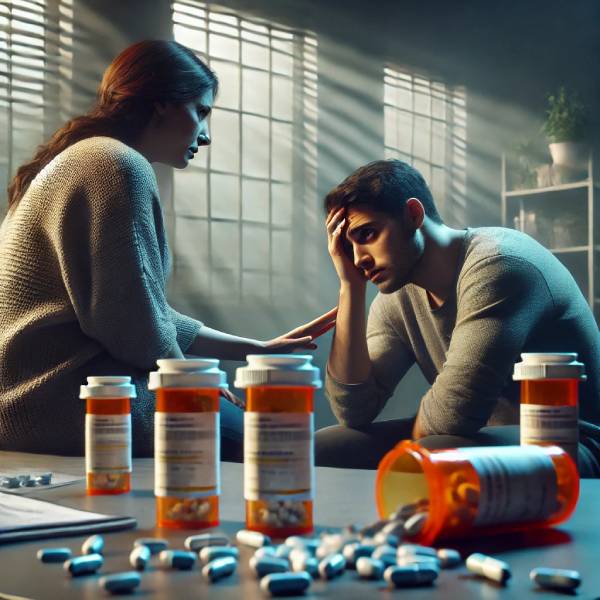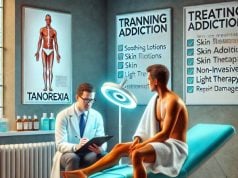Misusing a prescribed drug often begins innocently: an extra pill to chase stubborn pain, half a tablet more to still a pounding heart, or a roommate’s stimulant to cram for finals. Yet the brain’s reward network quickly learns the shortcut. Tolerance builds, doses climb, and the doctor’s refill calendar becomes a life-or-death countdown. Prescription medication addiction now rivals alcohol and illicit drugs in emergency-room visits, tearing at families, finances, and futures. This in-depth guide walks you through prevalence, root causes, red-flag behaviors, health fallout, and the most effective, evidence-based routes back to freedom.
Table of Contents
- Big-Picture Trends and How Common It Is
- Why It Happens: Biological, Psychological, and Social Drivers
- How to Spot It: Warning Signs, Symptoms, and Clinical Assessment
- Damage Done: Physical, Mental, and Relationship Consequences
- Getting Better: Proven Treatments and Steps to Long-Term Recovery
- FAQ
- Disclaimer
Big-Picture Trends and How Common It Is
From medicine cabinet to national crisis
Prescription medication addiction isn’t limited to any one age group, profession, or postcode—it unfolds wherever pills are plentiful and pain, stress, or sleeplessness demand quick relief.
Key numbers at a glance
- Opioid prescriptions have fallen from their 2012 peak, yet more than 3,500 people still start misusing pain pills each day.
- Benzodiazepine prescriptions rose nearly 50 % in the past decade; roughly one in ten adults received a script last year.
- Stimulant misuse affects up to 15 % of university students, with non-medical use highest around exam seasons.
- Poly-drug overdoses involving an opioid plus a sedative account for over half of prescription-related fatalities.
Why the true scope remains hidden
- Medical legitimacy hides escalation (“They’re doctor-approved—how bad can it be?”).
- Shifting suppliers—online pharmacies, social media, and “pill parties”—blur tracking efforts.
- Stigma and shame keep many users silent until a health or legal crisis forces disclosure.
Takeaway: Although exact prevalence is murky, every data source shows a steady uptick in harm, proving this is no fringe issue.
Why It Happens: Biological, Psychological, and Social Drivers
Prescription drug addiction flourishes where brain chemistry, personal history, and environment intersect.
Neurochemical hooks
| Drug class | Primary target | Reinforcement pathway |
|---|---|---|
| Opioids (oxycodone, hydromorphone) | μ-opioid receptors | Dopamine surge produces intense relief and euphoria. |
| Benzodiazepines (alprazolam, clonazepam) | GABA-A receptors | Amplifies inhibition, calming fear circuits; brain down-regulates natural GABA over time. |
| Stimulants (amphetamine, methylphenidate) | Dopamine & norepinephrine transporters | Heightened focus and energy reinforce performance use. |
| Hypnotics (z-drugs) | GABA-A α-1 subunit | Rapid sleep onset trains nightly reliance. |
Repeated use alters receptor density, lowers natural neurotransmitter output, and wires craving into the basal ganglia—the same region that drives thirst and hunger.
Psychological catalysts
- Unresolved trauma or chronic anxiety: Pills numb distress within minutes, discouraging therapy.
- Perfectionistic or high-achievement mindset: Stimulants become productivity tools until dependence sets in.
- Low frustration tolerance: Quick fixes feel easier than slow behavioral changes (e.g., physical therapy for pain).
- Co-existing mental illnesses: Depression or ADHD doubles the risk of non-medical dose escalation.
Environmental accelerants
- Easy refill culture: Automatic e-prescribing renewals postpone hard conversations about tapering.
- Leftover medications: 60 % of misusers cite a friend or relative’s medicine cabinet as their first source.
- Economic pressure and social isolation: Financial strain and loneliness heighten the lure of chemical escape.
- Marketing messages: Direct-to-consumer ads normalize long-term pharmacological fixes for stress and sleeplessness.
High-risk snapshots
| Scenario | Addiction pathway |
|---|---|
| Older adult on high-dose oxycodone after surgery | Insufficient follow-up → tolerance → doctor-shopping. |
| College student tries a roommate’s ADHD pills | All-night study “success” → weekend stimulant binges. |
| New parent prescribed lorazepam for anxiety | Nightly dose creeps upward → daytime reliance. |
Early recognition, honest dialogue, and alternative coping skills can derail these spirals before addiction cements.
How to Spot It: Warning Signs, Symptoms, and Clinical Assessment
Because medications come in pharmacy bottles, their misuse often flies under the radar longer than street drugs.
Behavioral red flags
- Dose creep: Running out days early, requesting “lost” prescriptions.
- Preoccupation: Counting pills, planning life around refill dates.
- Multiple prescribers: Urgent-care visits or telehealth chats to obtain extras.
- Risky combinations: Washing an opioid pill down with wine or a benzodiazepine for greater effect.
- Withdrawal avoidance: Cancelling trips or events for fear of being without medication.
Physical and emotional cues
| Substance | Common withdrawal clues |
|---|---|
| Opioids | Sweating, muscle aches, yawning, diarrhea. |
| Benzodiazepines | Tremors, panic spikes, sensory hypersensitivity, seizures in severe cases. |
| Stimulants | Exhaustion, low mood, hypersomnia, intense hunger. |
| Hypnotics | Rebound insomnia, irritability, palpitations. |
Clinical diagnosis
A Prescription Medication Use Disorder is confirmed when at least two DSM-5 criteria occur within twelve months, including tolerance, withdrawal, craving, and life disruption. Severity:
- 2–3 criteria = mild
- 4–5 criteria = moderate
- 6+ criteria = severe
Assessment toolbox
- Prescription Drug Monitoring Programs (PDMPs) reveal overlapping or excessive fills.
- Urine drug screens detect unexpected substances or absence of prescribed meds (suggesting diversion).
- Structured interviews such as the PDUQ quantify misuse behaviors.
- Functional scales gauge whether pain, sleep, or anxiety truly improve with ongoing use.
Pro tip for families: Keep a discreet log of concerning behaviors; objective details help clinicians craft targeted support.
Damage Done: Physical, Mental, and Relationship Consequences
Prescription drug addiction wages war on every body system and social role.
Medical fallout
- Respiratory suppression (opioids, benzos) raises overdose death risk.
- Hormonal disruption: Long-term opioids lower testosterone, inducing fatigue, osteoporosis, and sexual dysfunction.
- Cognitive decline: Benzodiazepine overuse links to memory lapses and increased dementia risk.
- Cardiovascular strain: Stimulants elevate blood pressure and arrhythmia danger.
- Sleep-behavior disorders: Z-drug users may sleep-walk, cook, or even drive without recall.
Emotional and cognitive toll
| Domain | Impact |
|---|---|
| Mood | Depression, irritability, emotional numbness. |
| Anxiety | Amplified during withdrawal or supply shortages. |
| Motivation | Decreased interest in non-drug rewards. |
| Executive function | Impaired planning, focus, and impulse control. |
Social, occupational, and legal ripples
- Relationship erosion through secrecy, financial drain, or erratic mood swings.
- Career decline due to absenteeism, poor performance, or failed drug tests.
- Financial chaos from cash-pay scripts or black-market purchases.
- Legal problems—fraudulent prescriptions, driving under the influence, theft.
Hidden casualties
- Children accidentally ingesting unsecured pills.
- Elders confused by complex regimens, leading to double-dosing.
- First responders facing fentanyl-laced counterfeit tablets during calls.
Key message: The ripple effect reaches far beyond the person taking the pill.
Getting Better: Proven Treatments and Steps to Long-Term Recovery
Recovery is more marathon than sprint, demanding medical, psychological, and social support.
Phase 1: Safe withdrawal and stabilization
- Medically supervised tapers prevent dangerous rebound effects (especially with benzodiazepines and high-dose opioids).
- Medication-Assisted Treatment (MAT) options:
- Buprenorphine, methadone, or extended-release naltrexone for opioid addiction.
- Anticonvulsants, beta-blockers for benzo or stimulant withdrawal discomfort.
- Symptom relief: clonidine for opioid hyperarousal, hydroxyzine for anxiety, melatonin for sleep.
Phase 2: Core therapeutic modalities
| Therapy | Key focus | Practical example |
|---|---|---|
| Cognitive-Behavioral Therapy (CBT) | Restructure drug-use thoughts | Replace “I can’t sleep without a pill” with evidence-based sleep hygiene. |
| Motivational Interviewing (MI) | Resolve ambivalence | Explore pros/cons of continued use from patient’s viewpoint. |
| Dialectical Behavior Therapy (DBT) | Emotion regulation | Teach distress-tolerance skills to ride out cravings. |
| Contingency Management | Reinforce abstinence | Vouchers for negative urine tests. |
| Trauma-focused therapy | Address root pain | EMDR or somatic processing for PTSD underpinning misuse. |
Phase 3: Building a relapse-proof life
- Trigger audit: Identify cues—time of day, emotional states, people—that precede craving.
- Alternative routines: Walk, journal, deep-breathing, call sponsor during cravings.
- Medication lockboxes & pill counters to prevent impulsive extra doses.
- Support networks: 12-Step meetings, SMART Recovery, or faith-based groups.
- Regular health maintenance: Exercise, balanced diet, sleep hygiene to restore neurotransmitter balance.
- Digital defenses: Unfollow pill-promoting forums, install app blockers during vulnerable hours.
Phase 4: Long-term growth and purpose
- Vocational rehabilitation or return-to-work programs.
- Continuing education—GED, online certificates, college re-entry.
- Creative outlets—music, art, woodworking channel emotion into achievement.
- Advocacy and service—sharing recovery story strengthens commitment and inspires others.
Hope highlight: Research shows people engaging in MAT plus counseling for at least a year more than double their chances of sustained sobriety compared with counseling alone.
FAQ
Is it safe to quit prescription drugs cold turkey?
Stopping some medications suddenly—especially benzodiazepines or high-dose opioids—can trigger seizures, heart problems, or severe distress. Always consult a medical professional for a tapered plan.
How long does recovery take?
Detox may last days to weeks, but rewiring habits and brain chemistry generally takes months to years. Consistent support speeds healing and reduces relapse risk.
Does Medication-Assisted Treatment just replace one addiction with another?
No. MAT doses stabilize brain chemistry without producing the euphoric high, allowing people to rebuild lives while reducing overdose deaths.
Can someone manage chronic pain without opioids after addiction?
Yes. Multi-modal pain plans—physical therapy, non-opioid meds, mindfulness, nerve blocks—provide relief while safeguarding recovery.
Do all stimulant prescriptions lead to addiction?
When taken exactly as prescribed under medical supervision, addiction risk is low. Misuse—higher doses, crushed or injected pills—increases risk dramatically.
How can family help without enabling?
Set clear boundaries, lock up all medications, attend family therapy, learn CRAFT techniques, and encourage professional treatment while practicing self-care.
Disclaimer
This article offers general education and is not a substitute for personalized medical, psychological, or pharmaceutical advice. If you suspect prescription medication addiction in yourself or someone you love, seek qualified professional help immediately.
If this guide helped you, please share it on Facebook, X (formerly Twitter), or any platform you enjoy, and follow us for more compassionate, science-based resources. Your support inspires us to keep creating content that changes lives—thank you!











